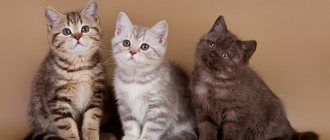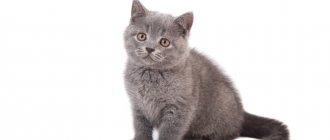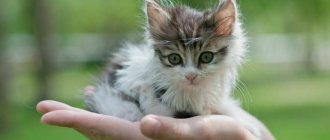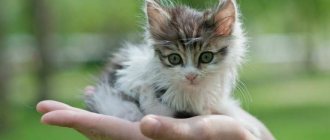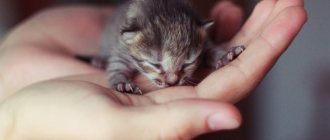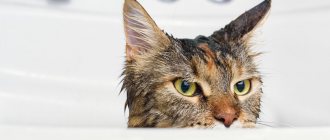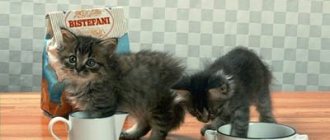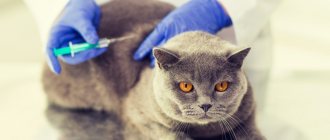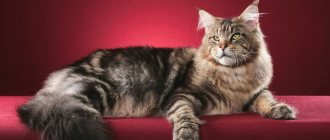When a small British cat appears in your home, you should think not only about how to take care of him, but also about how to raise him. Yes, this breed of cat is not much different from ordinary cats, but they have one twist. And this is their highest intelligence! It is because of this that owners need to have a certain approach.
Naturally, when you see a little fluffy bear in front of you, it seems that he is the best in the world. However, each kitten has its own character and its own rules, but it is worth considering that he lives in your house, then it is you who needs to establish rules for him from the first day.
British kids, like children, if you put something in them from the very beginning, it will be the key to success.
Cats of this breed are often very calm and balanced, but this does not mean that they will not be playful. Moreover, all small pets have incredible energy and curiosity.
Description of the breed of British kittens
Most of all, little Britons look like charming plush toys: a round muzzle, huge eyes, small ears with rounded tips, soft short fur.
The colors of the breed are varied: red, white, black, tortoiseshell, tabby, more than 200 varieties in total. The physique is strong, they give the impression of strong heroes.
The chest is wide, the paws are neat, the toes are gathered into a ball. The nature of the kids is good-natured, they easily get used to all family members, without singling out favorites. They get along easily with other animals and are loyal to children.
It is advisable to buy a British dog from a nursery or through a club. In this case, purchasing a kitten, which after six months has turned into an animal whose grandmother, as Bulgakov said, sinned with a diver, tends to zero. These babies have documents confirming their belonging to the breed.
In the future, the pedigree will allow us to participate in exhibitions and give access to breeding. If the owner is far from the idea of winning prizes at competitions and just wants a pet of a certain appearance and character, you can buy a kitten from trusted breeders who are ready to present both parents and vouch for the purity of the blood in the absence of a metric.
What goes around comes around!
Here the law plays a role, as with a small child. Everything is very simple! What a person puts into his personality from a very young age will begin to manifest itself in the near future. Therefore, you should not lose sight of some of the British cat’s pranks, because this is how its character is formed.
Realizing that it is possible to do this, she will grow up, but not change. Don’t think that the kitten will grow up and the crap will come out of his head on its own! It is unlikely that you will then appreciate riding on curtains, attacks on your feet, damage to furniture, chewed wires, and so on. Therefore, the owners of such a cat should gently suppress these moments in its behavior.
There are some proven, but safe for a cat methods that can wean him from such pranks.
You can:
- blow into your pet's face. All cats do not like this action, and therefore immediately try to evade the crime scene;
- Sprinkle a few drops of water on your pet. As usual, kittens do not like water, so they will take this action as punishment. However, you should avoid getting water into your ears and eyes;
- With a very light movement of your palm, you can hit the kitten on the nose. But keep in mind that this must be done carefully and without the use of physical force!
In the same way, you need to approach the animal with questions of food. Don't poke his nose into his plate because he doesn't want to eat. It's usually best to leave him alone, and when he gets hungry, he'll be looking for something to eat anyway.
But this method is suitable if you feed your Briton high-quality food, because it may turn out that in the nursery the cat ate top-class food, high-quality and tasty, and you give him cheap food, which is not only tasteless, but also does not contain there is absolutely nothing useful in itself.
Naturally, a Briton will refuse such food, and therefore there is no point in forcing unhealthy food into him! If you are sure that you are feeding your four-legged friend the right food, then sooner or later he should realize this.
Also, pet care includes a certain sequence in taking pills and vaccinations. To do this, you should keep a notebook where you can note the last time your cat was vaccinated and when you gave him anthelmintic drugs.
All this will help you accustom your pet to routines and consistency!
British kitten: at what age can you adopt
Most people want to adopt a pet at the age of 4-6 weeks, citing the successful experiences of friends. It's nice to play with the baby, watch his growth, the formation of his character. But for the fluffy one, weaning from his mother before 12 weeks is a traumatic factor.
By three months, the young Briton had completed a full course of breastfeeding, which has a positive effect on the immune system, the functioning of the digestive tract, and was separated from his mother by her own mother, without any trauma to the delicate child’s psyche.
The kitten has acquired the skills to use a litter box, can eat on its own, and has passed the first stage of vaccination. He is less dependent on his brothers, sisters, and cat.
He makes contact with strangers more easily and is ready to explore the big world. It will be easier for him to settle into a new home, get used to other people, and learn to communicate with animals (if he has any). The optimal age for introduction into a new family is 10-12 weeks.
Be sure to read:
Is it possible to cross a Briton and a Scot: why is it not recommended when mating is possible?
Feeding a kitten
Up to 6 months, little British babies are fed 4-6 times a day. Then the frequency is reduced to 3 times, and by 8 months to 2 times. When feeding naturally, the products are as follows:
- Meat (beef, turkey, chicken) – from 60 g daily;
- Milk or kefir – up to 80 g 3-4 times a week;
- Cottage cheese – 3-4 times a week;
- Vegetables, cereals with meat - periodically;
- Sea fish – once a week;
- Egg yolk – once a week.
Meat is given to the kitten after long-term freezing in the form of minced meat or small pieces. You can mix it with water-based cereals. A drop of honey is added to boiled or pasteurized milk, but it is useful for up to 3 months, then it is replaced with fermented milk products.
The fish is boiled and removed from the bones. The yolk is also not given raw, and the white is harmful to kittens. A drop of vegetable oil, which is poured into the porridge every other day, is considered a useful additive.
Dry food should be suitable for large breed kittens. At first, it is sometimes soaked with warm water or kefir. Use pates or mousses for kittens according to age.
Important: If milk causes stomach upset, it should be immediately excluded from the diet. It is advisable to boil the chicken to reduce the risk of salmonellosis.
What should you buy for a British kitten?
You should prepare well in advance for the arrival of a British kitten in your apartment; the list should include:
- A carrier - in it the baby will come home, visit the clinic, etc.
- A rubber comb that does not damage the thick undercoat;
- Three bowls – two smaller ones for dry and wet (natural) food, a larger one for water;
- Tray and shovel for solid waste;
- Tray filler – pressed sawdust, flavored granules, silica gel. Any option has its supporters, it is better to purchase the one that the kitten is accustomed to from the breeder;
- Toys - balls, sticks with feathers, wind-up mice;
- A house and a scratching post.
You need to create a first aid kit: thermometer, pipette, small syringe, activated carbon, manganese, disposable syringes, cotton swabs, bandage, bandage.
Preliminary list of items
To make your Briton’s life pleasant and comfortable in your apartment or house, you need to take care of creating a calm atmosphere and also buy a number of accessories. This will make it easier to care for.
- "Sleepy" place
- Special feeding bowls and food
- Toilet and litter
- Carrying house
- Combs or brushes for grooming
- scratching post
- Toys
Purchases do not depend on how you received the cat - it could be a gift, an informed purchase, or a choice from a shelter. Caring for and feeding a British kitten is very simple if you figure everything out before purchasing the animal.
© shutterstock
How to care for a British kitten
Acclimatization takes about 2-3 days. At this time, the attitude towards the new resident should be even, friendly, and not intrusive. Let him look around calmly. Places for toileting and feeding are determined immediately, shown to the kitten and not changed. Potentially hazardous areas should be fenced off.
If the baby crawls under the sofa, you don’t need to force him out behind the closet; after a while he will crawl out on his own. Children are given preliminary instructions, explaining that the animal cannot be constantly disturbed or disturbed while eating or sleeping. Forbid him from dragging him by the tail, squeezing him incessantly, or hurting him.
Once settled, the Briton will not require any special care. It is enough to keep the tray dry, clean, bowls full (dry food) or feed hourly (natural food), change the water daily, and comb the coat. This breed is quite independent, but the growing pet provokes the owners to play, comes to lie next to them, and caresses them.
What and how to properly comb British kittens?
The plush coat is a distinctive feature of the breed. You will have to teach your baby to comb from the first days. It is better to purchase several accessories to keep the fur in decent shape: a rubber mitten, a comb for the undercoat (used as needed), a comb that imitates a cat's tongue.
It massages the skin well and removes fallen hairs. British cats are combed against the grain and in the direction of hair growth. You cannot use a slicker brush; it will ruin the undercoat.
During the active molting season, cats are given special means to free their stomachs from lumps of licked fur - bezoars. It is worth bathing your pet in case of severe contamination, no more than 1-2 times a year.
The use of human, including baby shampoos and soaps is strictly prohibited. It is necessary to buy a special product for short-haired breeds, taking into account the color, and rinse thoroughly after soaping. Treatment with flea and tick medications is periodically necessary, especially for individuals walking on the street.
How to raise a British kitten
The British respond to affection. You can't force someone to follow the rules. You cannot hit a kitten with your hand or with a newspaper, it will be afraid of people and run away. The popular method of sticking your muzzle into a puddle or a pile can cause fear, and the situation will repeat itself due to the negative reaction of the animal.
Be sure to read:
Marbled Briton: types and characteristics of color, character and habits, how to breed, care
Moreover, you should not throw a slipper at a kitten, this is akin to throwing a chair at a guilty child. The size and weight of a slipper multiplied by the acceleration of the flight can cause serious injury: concussion, fracture, severe bruise. Feeling love, the pet will strive to adapt to the owner’s requirements, wanting to receive praise and a treat.
Love is the key to success!
The British are quite smart cats. They are easy to accustom to some rules in the house, for example, going to the litter tray. Of course, every baby can have some mistakes. However, in this case, you should not shout at the kitten, much less hit it.
For them, it is enough to change their intonation and show their dissatisfaction. But it also happens that the owners themselves are to blame for the little Briton’s mischief.
For example, if this concerns the toilet, then perhaps the tray is in a rather inconvenient place or there is not enough filler in it, or maybe it is already all wet. That is, before punishing your pet, you should take a good look around and understand the reason why he did this.
If the fault is on his side, then by indicating his place, the British cat will most likely quickly understand everything and will fulfill your requirements.
Of course, in matters of upbringing, love and attentiveness play a huge role. When a person has such qualities, he will under no circumstances treat the kitten as a toy. Such a responsible owner will not undertake physical violence, and an even wiser owner will turn to a specialist for help if something in matters of education goes wrong.
How and what to feed British kittens
A growing body needs food that satisfies it with calories, nutrients, and vitamins. You should not offer kittens food prepared for people: salt and spices are dangerous to the animal’s health.
The following are strictly excluded:
- fat meat;
- River fish;
- smoked meats, pickles;
- sweets;
- bakery products.
Proper, nutritious nutrition is the basis for good health and a long life for your pet.
Dry food for British kittens
Selected according to age. You need to choose a quality premium, holistic, super premium product. Such food is made from good meat, vegetables, contains vitamin supplements, and is balanced in composition. Cheap “Whiskas”, “Friskas”, etc. are made from feathers, waste from the meat industry, and grain husks.
Gluten and starch contained in excess cause allergies. A table with serving sizes is indicated on the packaging. Ready-made dry food is a convenient option for working owners. The animal must have free access to water.
Feeding a kitten with natural products
A natural diet must include:
- lean meat - veal, chicken, beef;
- offal - heart, liver, kidneys, lungs, stomachs;
- sea fish;
- raw vegetables;
- steamed rice, buckwheat.
- eggs, dairy products.
The meat is pre-frozen for 2 days to kill the worm eggs, the fish is boiled until half cooked, and separated from the bones. Cereals and vegetables are mixed with protein foods in a 2/1 ratio.
Toilet
Caring for British kittens includes litter box training. If you bought it at a nursery, most often they have already begun to accustom the animal to the tray, to the place. In this case, be sure to ask the breeders which filler should be used. Next, just show the cat the tray several times - it’s better to do this after eating. He will quickly remember its location and will not dirty the territory. The main thing is to clean the toilet on time, and in fact, this will be the entire care of the British in terms of waste . Remember that animals must be kept clean, no matter what breed they are.
Proper care of newborn kittens includes the process of litter box training as soon as they begin to grow. It is better to buy an older British dog, since training is quite difficult - especially if the animal is wayward.
© shutterstock
British kitten: when to vaccinate
Before vaccination, it is necessary to treat the kitten against fleas, and 2-3 days after disinfestation, give an anthelmintic drug. After 10 days, antihelminthic measures are repeated and after another 10 days you can go for an injection.
The first time vaccination is carried out at the age of 10-12 weeks, using a complex drug (Nobivak, Multftel-4, Felovax, etc.), which protects against:
- rhinotracheitis;
- calcevirosis;
- panleukopenia.
After three weeks, revaccination is done. After 14 days, the body will develop immunity and the cat can be released outside and transported around the city. Rabies vaccination is given separately. It is convenient to get a passport; it states the dates of vaccinations and what drug was used.
Without such a document, the animal cannot take part in exhibitions, club matings, travel on the train, or cross the border. Vaccinations are done annually. This procedure is necessary for all cats, including those who do not go outside. An infection can be brought into a home by a person on clothes or shoes.
Be sure to read:
Is it possible to breed a fold-eared cat with a fold-eared cat: why not, with whom to cross
Brushes
For British kittens, it is worth purchasing a rubber brush, preferably oval-shaped, which will be equipped with small teeth made of soft material. It will allow you to carry out care painlessly: it will remove “static” - electricity that accumulates on the fur, and it is easy to massage the skin without injury. Since Britons have short fur, there is no need to groom it in any special way. If the kitten sheds, wet your hand in warm water and massage the animal’s fur and skin . Caring for British Fold kittens in terms of fur is absolutely not difficult.
© shutterstock
Common diseases in British kittens
British kittens born in a good cattery and given the right care are more likely to have good health. They can get a cold by sitting in a draft, being in a cold room for a long time, or on the street.
Infectious diseases are dangerous for them, so you should not ignore timely vaccination. When contacting infected animals, they “catch” lichen, ear mites, fungus, etc.
Of the breed-specific pathologies, it is worth noting hypertrophic cardiomyopathy (HCM). It manifests itself in adults; for timely detection, it is recommended to perform an ultrasound of the heart at the age of 1 year, and then repeat the procedure every 2 years.
Sometimes owners are faced with pet diarrhea caused by poor diet, hair loss due to stress, liver and kidney disorders, vitamin deficiency, claw fungus, and tartar.
Pet hygiene
It is worth understanding that the sooner you accustom your furry friend to all procedures, the faster and easier it will be for him to endure them. For example, it is best to clean a Briton’s ears and trim his claws at a certain time interval, so he will get used to these procedures without problems.
By gradually getting used to such manipulations from early childhood, your little friend will experience less stress. And even more so, it will be easier for you to persuade him to use these types of hygiene.
If you need to bathe a kitten (this should not be done unnecessarily), then cut off its claws in advance, put a towel in a basin and lightly water it from top to bottom.
In the first 2-3 months, kittens develop habits, rules and character, so only you can influence him, both in a positive and negative light!
First moult and grooming
A kitten's first shedding occurs at seven or eight months of age. During the week, the kitten should be carefully combed every day with a special comb, running through the fur with massage movements. After this procedure, you can walk over the fur with your hand in a wet rubber glove, thus collecting the remaining fur. Subsequent molting occurs on an individual basis, depending on many factors - vitamin deficiency, allergic reactions, existing diseases, age-related and hormonal changes, and the use of inappropriate bathing products.
Regular grooming of the British dog's coat with special combs will preserve the beauty of the coat.
You need to groom your pet regularly:
- weekly brushing will bring many benefits to your pet. Firstly, this procedure will rid the cat of dead skin particles and fur hairs, which means that when licking, less of them will end up in the stomach. Secondly, regular brushing gives the animal a healthy and well-groomed appearance;
- if you accustom your kitten to water procedures from an early age, then bathing can become one of your pet’s favorite activities, which can be used both when soiled and for preventive measures;
- Careful trimming of the claws will rid the pet of the rough, keratinized part, which flakes off over time, causing the claws to begin to cling and cause discomfort to the cat. The procedure is short, only a couple of times a month. The haircut is carried out with special scissors, carefully so as not to damage the blood vessel;
- regular preventive examination of the auricle and organs of vision, when the cat’s ears are cleaned of wax accumulation, and the eyes are wiped with black tea infusion or eye drops.
From an early age, a kitten needs to be accustomed to the necessary procedures, then he will calmly endure them and even enjoy them
How to brush British cats?
Before purchasing a British kitten, you should buy special combs at a pet store. To care for your pet you will need:
- a comb with metal teeth with rounded ends so as not to injure the animal’s skin. Needed for primary combing of wool of any length in the direction from head to tail according to hair growth;
- comb with massage effect. Stimulates blood circulation, provides beautiful fur for your pet by combing out dead skin particles and dead hairs. You need to comb your pet with such a comb carefully so as not to damage the delicate undercoat;
- rubber brush or glove. Helps complete your pet's grooming routine. With the help of such a brush you can remove remaining hairs from the surface of the coat after active combing.
A variety of pet grooming products to choose from allows you to keep your cat's coat healthy and beautiful.
Bathing
The first bath of a kitten should be careful and not earlier than one month of age, so as not to scare the baby and not instill a negative impression of the procedure. It is better to teach the kitten to bathe in a playful way, touching the kitten with wet hands, and then gently moistening the baby’s fur with a few drops of warm water. This way, the kitten won’t get scared and won’t start to struggle, and the water, rolling off the fur, will attract attention and interest.
Gradually, with the help of play, the kitten will get used to the water and will allow its body to be completely wet, while you can also gradually begin to use special shampoos that do not have a strong odor. The only exception can be shampoos against parasites, the pungent smell of which can scare away the “British”. Bathing a pet kept in an apartment should not be done more than once every two months, unless treatment or severe contamination of the animal forces it to be done more often.
What do you need to know? The shampoo should be selected based on the length of your pet’s coat and its color, as some products are designed to enhance the color of the animal’s coat.
A kitten's first bath should be no earlier than one month of age.
- fill the container with water, adjusting its temperature (about 30 °C);
- pour a special shampoo into the water that suits your pet;
- place the cat in a container with soapy water and gently, massaging the fur, wet the cat’s body;
- rinse off the product with clean warm water, being careful not to get it into your ears, they are very sensitive;
- After bathing, wrap the cat in a dry towel to thoroughly dry the wet fur;
- Place your pet in a warm, draft-free room.
If you gradually accustom your kitten to water procedures, then over time he will enjoy the process and will not be capricious.
Cat care - nail trimming
Claws should also not be ignored. You need to make sure that they do not flake or peel off. They need to be trimmed once or twice a month. Trimming the claws should be half the length of the entire nail.
It should be noted that near the base of the claw there is a large plexus of blood vessels; there is no need to touch it. Trimming your nails will help preserve your furniture, as your cat will be less inclined to sharpen its claws on the furnishings.
A British cat that has been properly cared for will always be cheerful and, most importantly, healthy.
Source
Concern for safety
You need to understand that all kittens are extremely curious, so they will definitely want to explore the entire house and even the street. The owner’s task is to ensure that the baby does not harm himself. Although the apartment is a fairly safe place, there are still certain risks.
It is necessary to hide household chemicals, medicines and other dangerous liquids. British cats may taste them and end up at the vet. Nothing should be left on the table, because even a small kitten can climb onto fairly high surfaces.
The doors to the bathroom should be closed, because the kitten can jump straight into the toilet and end up in the sink. Some even jump into a full bath, not knowing what awaits them there.
As for toys, it is better to put them away when the owner is not at home or goes to bed. When playing independently, there is a risk of swallowing something, chewing something, or even hitting something. In addition, it will be quite difficult to sleep if the kitten is running around the apartment.
It is better to close doors to the street, as well as windows, if you do not want the baby to accidentally run away and get lost. Moreover, as a child he will be in danger if he leaves the house. There are a lot of dangers outside, and the climate is not always suitable for the baby.
Is there a breed of British Fold?
If you try to find this breed in the list of FIFe or other international felinological organizations, you will fail. Officially, the “British Fold” breed does not exist (British breeds are divided into short-haired and long-haired, both of which have beautiful erect ears). What kind of cats are called “British Fold”?
The history of the origin of the fold cat breed
Cats with folded ears were first officially registered in 1961. The cat Susie became the ancestor of a new breed, which was later called the Scottish Fold. Cute plush cats with large bright eyes and a very balanced character quickly gained popularity and in 1976 were officially recognized as an independent breed. During the period of breeding work, an unpleasant fact was revealed: when crossing two lop-eared parents, the offspring have a number of genetic diseases and are not viable. Therefore, crossbreeding was carried out with other short-haired breeds: exotics, British and Americans. In this case, the litter could contain both fold-eared kittens (Scottish Fold) and babies with erect ears; they were called Scottish Straight (this variety later also received the status of an independent breed).
Currently, mixing Scottish cats with British Shorthairs is prohibited, as this contributes to the development of genetic diseases. The British Fold cat breed does not officially exist. Scottish Folds are offered under this name, but since the ancestors of this breed were also British, there is some basis for using such a name. Such pets touch with their appearance and captivate with their sweet character, so they enjoy well-deserved popularity.
Photo gallery: British and Scottish cats
Blue British Shorthair
Longhaired British (Highland) golden chinchilla color
Long-haired Scottish cat with straight ears (Highland Straight) tabby color
Long-haired Scottish fold cat (Highland fold) bicolor color
Shorthair Scottish cat with erect ears (straight) red tabby color
Shorthair Scottish Fold cat (fold) gray point color
Educational issues
Character and obedience depend on education. They approach the issue seriously and as responsibly as possible. The educational process is built depending on the individual characteristics of the kitten, but there are also general rules that must be followed.
- Under no circumstances should you play with your baby's hands. The animal will decide that biting and scratching is natural and it will be problematic to prove otherwise in the future. There are toys for play.
- You can’t swing, much less hit, a new tenant. The pet will be afraid of the person and feel fear from an outstretched hand.
- Unwanted actions are stopped by clapping your hands or sternly shouting, but not in such a way that the animal pees in fear or hides in a corner for a long time.
- Any punishment must be timely, that is, carried out at the time of the crime, and not after a long period of time. In the latter case, the animal still will not understand why he received the kick and will harbor a grudge.
Caring for a Scottish Fold
Teach your pet to preventive procedures from childhood. In this case, he will get used to it and it will be easy for you to care for him.
The kitten's eyes should be constantly inspected and wiped with a cotton swab dipped in water as needed. Use a different cotton swab for each eye.
You should contact your veterinarian if you notice brown tears, a prominent third eyelid, or if your cat frequently rubs its eyes or squints.
Short-haired cats should be brushed once a week, while long-haired cats should be brushed every day. It is worth noting that the British, unlike the Scots, love combing against the grain.
Bathing most often goes smoothly if your pet is accustomed to this from childhood. Do this as needed: when the cat is very dirty, fleas or dandruff appear.
The ears of Scottish Folds need to be cleaned once every two weeks using a cotton swab dipped in a special ear liquid. If you notice that your pet is constantly scratching its ears and shaking its head, examine it and if you find dark brown plaque or mites, consult a doctor.
The claws should be trimmed to 1-2 mm with a special nail clipper. For the front paws, do the procedure twice a month, for the hind paws - once. Be careful not to damage the blood vessel of the claw.
Source
